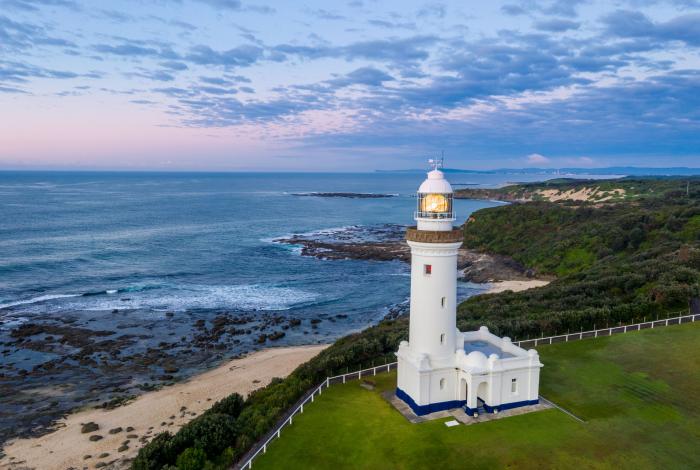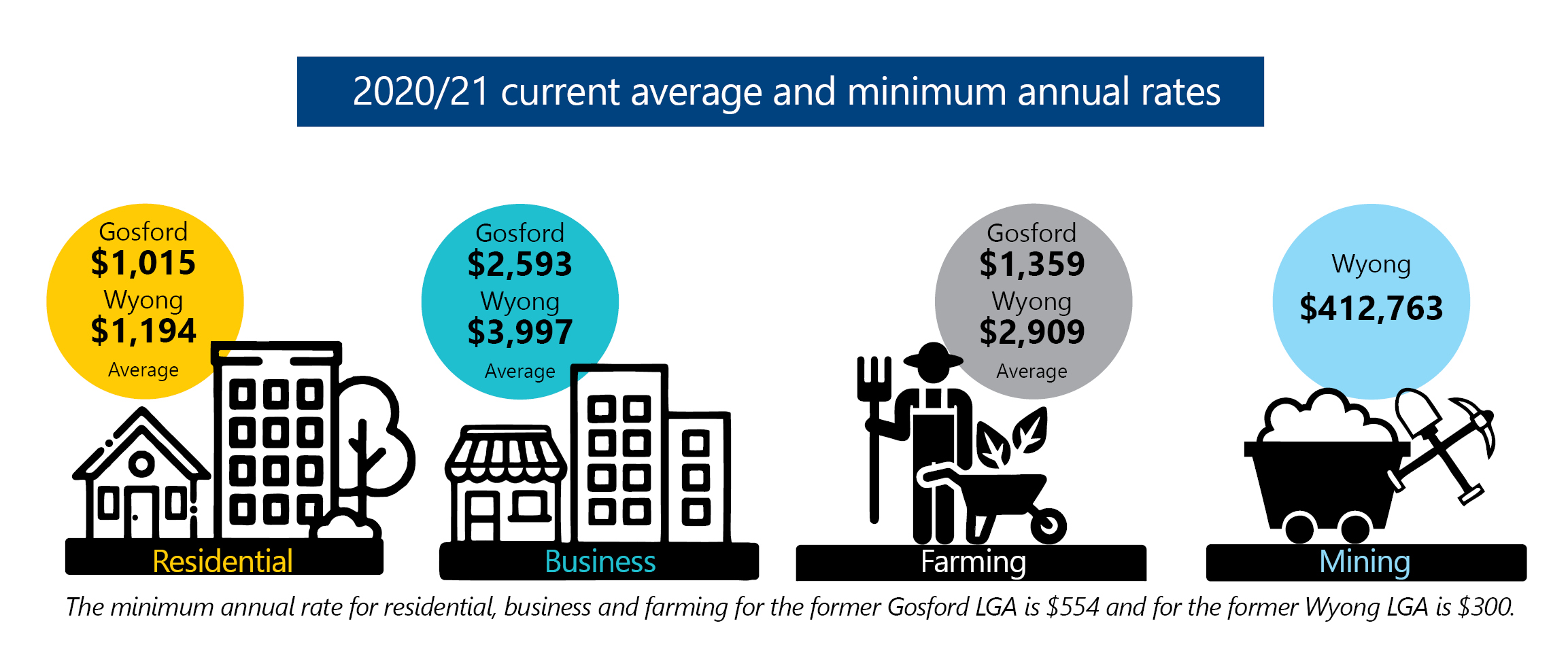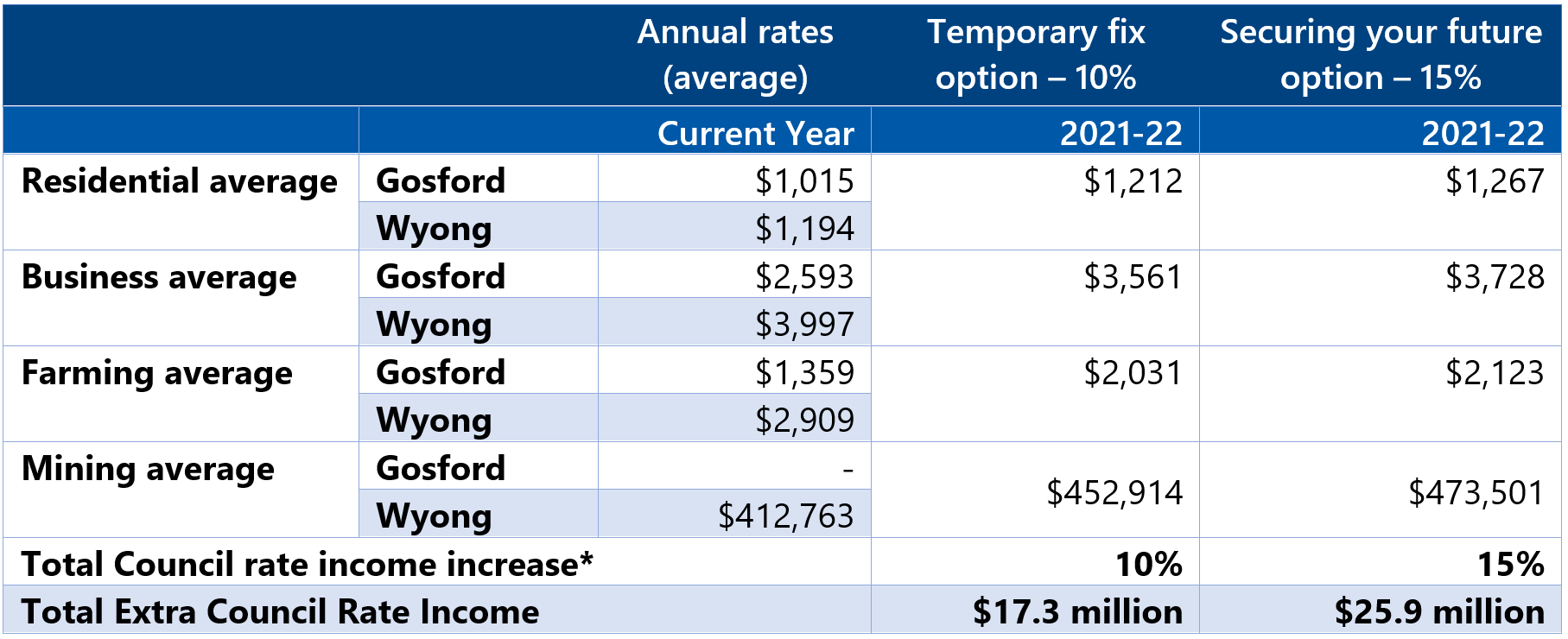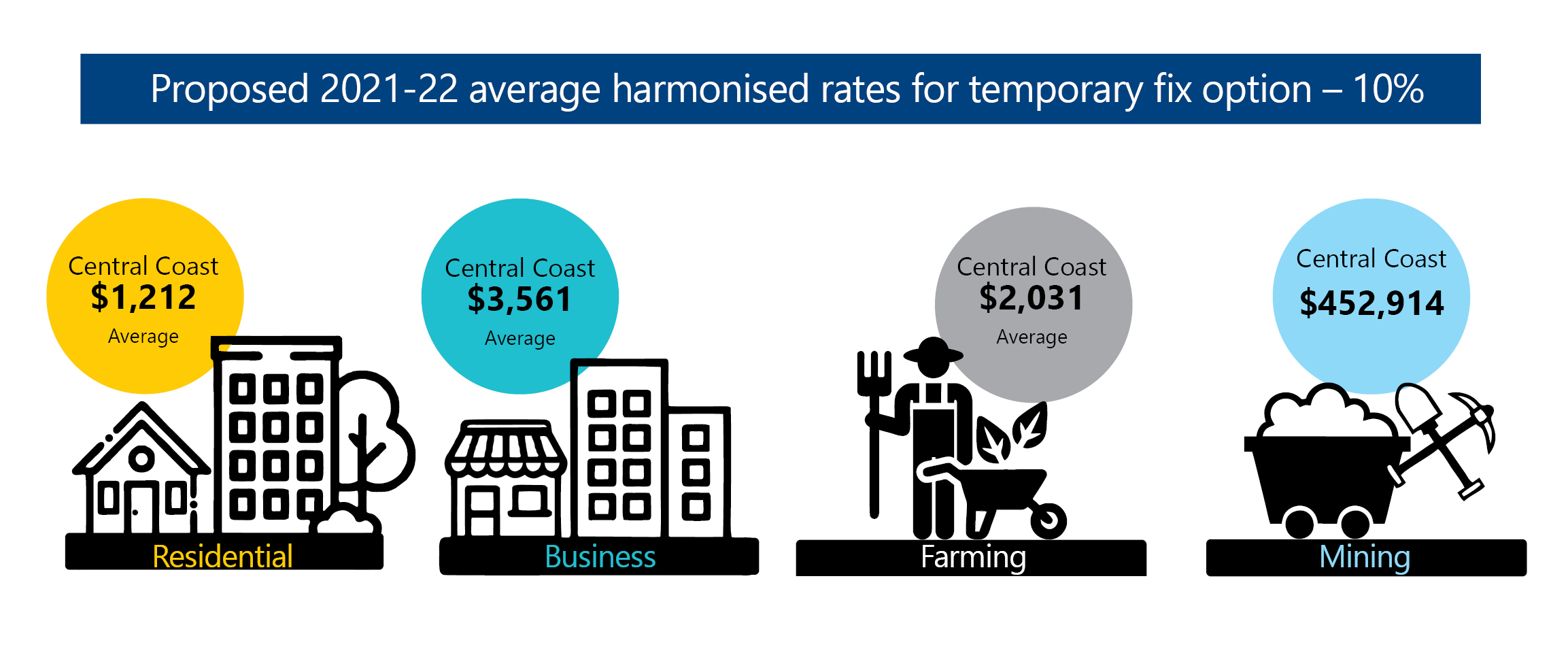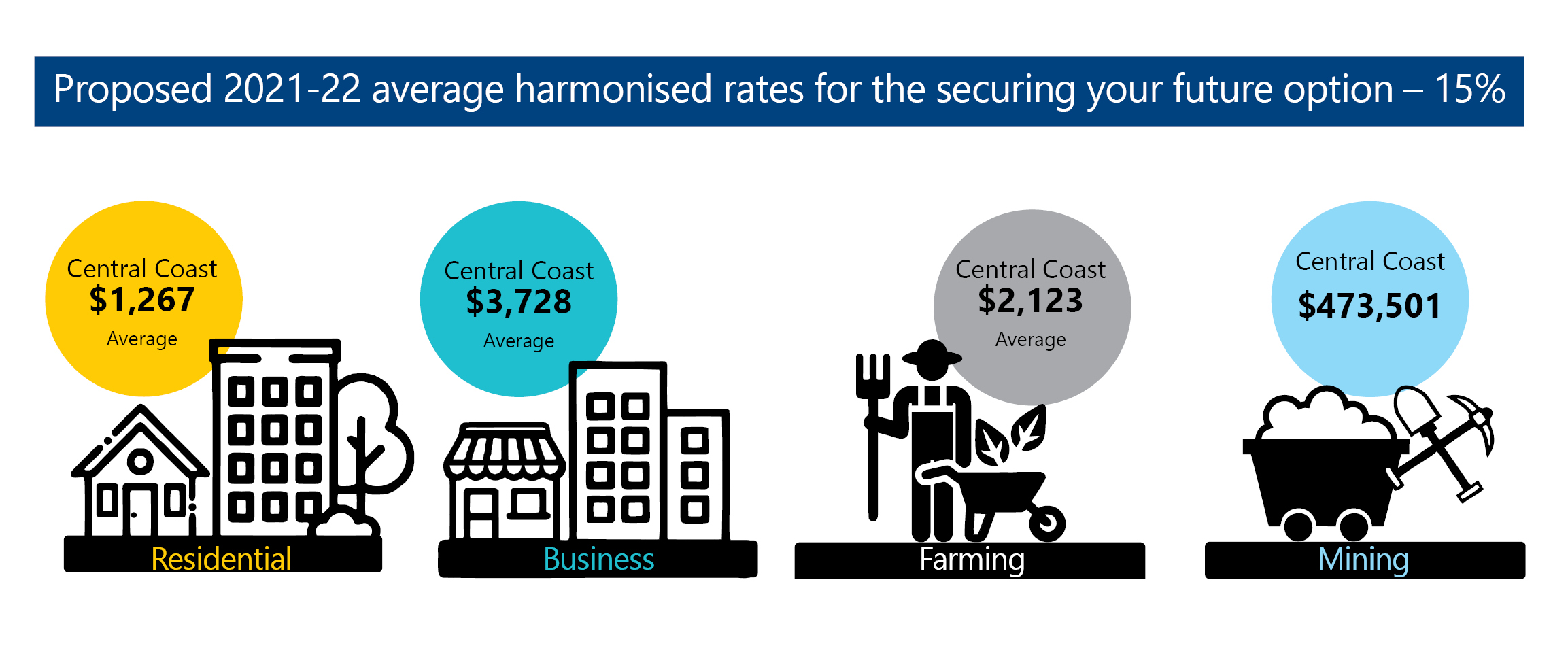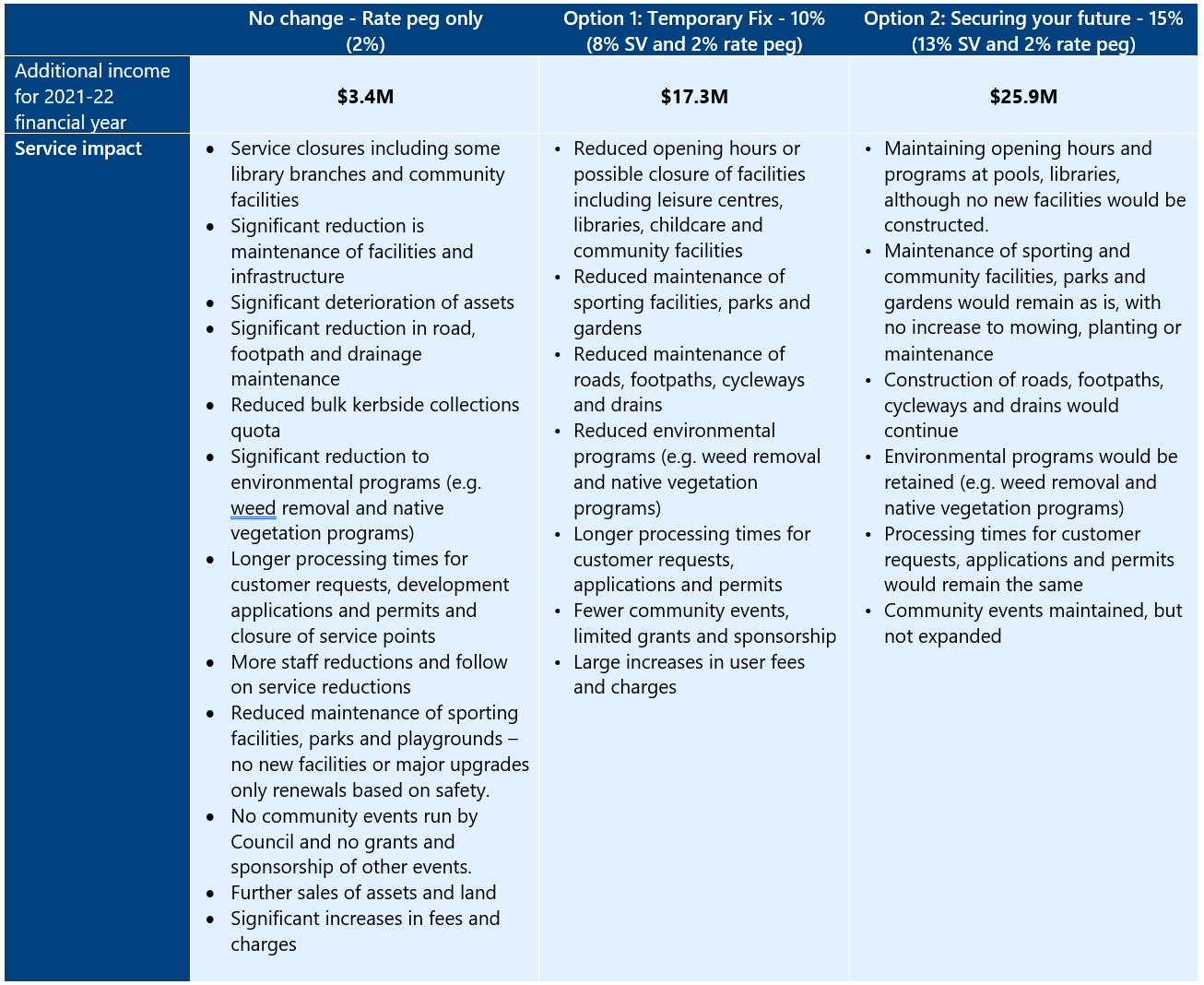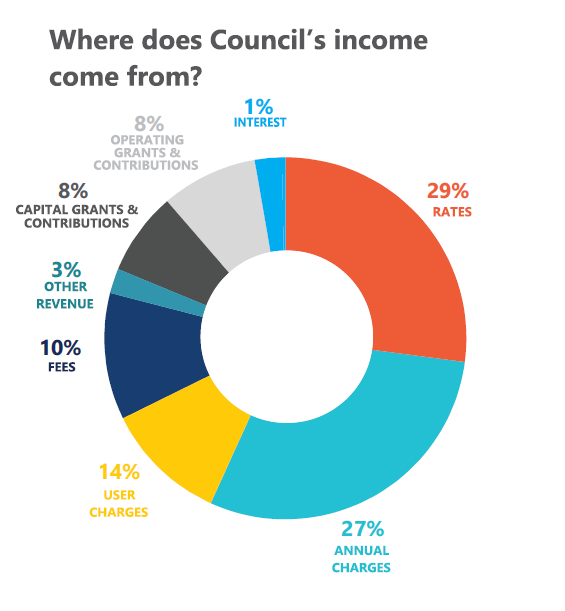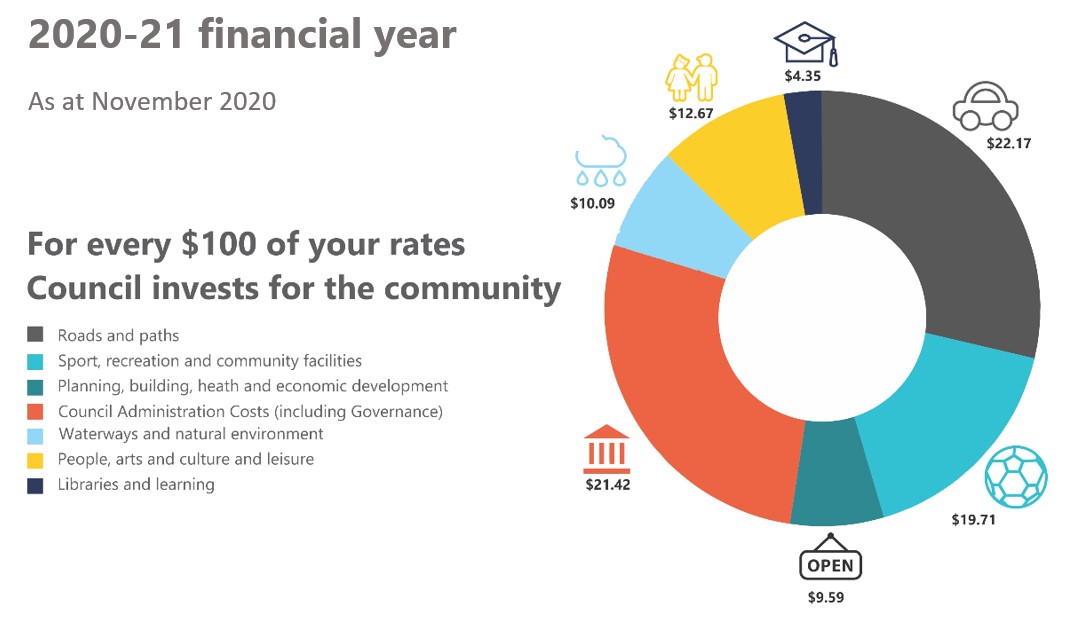Securing your future with a rate rise
We thank the community for providing feedback about Council’s application to the NSW Independent Pricing and Regulatory Tribunal (IPART) for a Special Variation (rate rise).
Council submitted its application to IPART in February 2021.
The Independent Pricing and Regulatory Tribunal (IPART) approved a 15 percent Special Variation (SV) rates increase for the Central Coast for three years starting from the 2021-22 financial year on the 17 May 2021.
Community consultation
Council sought community feedback on options for a proposed rate rise between 8 January and 1 February 2021 through two online surveys (an updated survey was launched on 22 January following community feedback).
The total number of responses for both surveys was 10,229. Survey one received 3,944 responses and survey two received 6,285 responses.
In addition, Council received over 378 written submissions as at 1 February 2021.
Throughout February, Council undertook a separate phone survey on the 15% special rate variation and continued to receive written submissions up to 26 February 2021.
Key findings from online surveys and written submissions to Council:
- A majority of survey respondents do not support a rate rise.
- Those who do not support a rate rise feel that ratepayers should not shoulder the burden of Council’s mistake/s.
- There is concern about the affordability of a rate rise for either themselves or others in the community.
- Some respondents feel Council’s maintenance of roads, open space and natural assets are already poor.
- Some respondents feel they already don’t get value for money paid due to a perceived lack of maintenance of Council assets, or lack of expected infrastructure in their immediate area, such as kerb and guttering.
- Some suggestions about alternatives to a rate rise include (but are not limited to) seeking NSW Government funds, increasing revenue from fines, selling assets, reducing staff, employee pay cuts, reduction of capital works and scaling back services and expenditure in general.
- A minority of survey respondents support a rate rise.
- The key reasonings behind support is to ‘fix the problem’, maintain services and/or to create a sustainable pathway forward for Council.
- Some respondents who support a rise also expressed a desire to improve the Central Coast through improved assets and economic growth and investment.
- General sentiment from respondents (either in support or against a rate rise) showed the community would like to understand who is accountable for the financial issue and what actions will be taken against these individuals or entities.
- Some respondents will continue to distrust Council, with others stating their expectations of better financial management and accountability in the future.
- There are some suggestions from respondents that corruption or fraud has occurred.
- There is overall strong support for the appointment a financial controller.
Preference out of three options from survey two results:
- 10.2*% preferred Option 1 – Temporary Fix - 10%
- 17.4% preferred Securing our Future – 15%
- 72.4% preferred No rate rise – rate peg only
*figures have been rounded
Key findings from the telephone survey:
Council commissioned Micromex Research to undertake a separate phone survey to measure levels of support and preferences for either a 15% Special Variation, or the rate page only option. This survey involved a randomly selected sample of residents to reflect and represent the population makeup of the Central Coast resident/ratepayer base. Summary:
- When respondents were exposed to the 15% increase option, 55% of residents were at least ‘somewhat supportive’ on a standalone rating question.
- Those unsupportive of the 15% rate increase nominated concerns around Council’s financial mismanagement and the community affordability issues.
- Those supportive of the increase did not want to see service levels decline and see that the increase is the only way that Council can address a serious financial shortfall.
- When respondents were exposed to the rate peg only option, 51% of residents were at least ‘somewhat supportive’.
- The overall preference between the two options was split with 55% of the community preferring the rate peg only and the other 45% preferring the 15% Rate Increase – with the difference between the two scores not significant.
The results of consultation can be found in the February 2021 consultation report and telephone survey report. These have been provided to IPART along with written submissions.
Council’s decision
On the 8 February 2021 Council resolved to apply to IPART for a 15% one-off permanent special rate increase. Council adopted the revised Long-Term Financial Plan (General Fund) as well as the Debt Recovery and Hardship Policy for purpose of public exhibition.
Council continues to have a serious financial situation.
Council has already commenced a number of measures to manage costs and increase income to address the situation and long-term financial sustainability. These include significant staff reductions ($31M), restrictions on spending ($22M), and the proposed sale of assets ($49M). The spend on infrastructure has also been reduced from $225M to $170M annually. These steps achieve 70% of the $76M annual savings target needed to action the financial recovery.
The remaining 30% ($23M excluding rate peg) will need to come from additional income to pay back the restricted funds unlawfully accessed. This income target can only be achieved with a 15% rate peg. It is for this reason that it is now recommended that Council proceed to apply to IPART for a rate increase of 15% (13% special rate increase and 2% rate peg increase).
Council resolved to consult on a 10% one-off special rate variation staying in the rating base for 7 years and a permanent rate variation of 15% one-off. This consultation was undertaken with most respondents not supporting any rate rise. Of those who did support a rate rise, when presented with the three options, 15% was preferred more than 10%.
It is clear from the community feedback that any decision to increase rates will be unpopular as our community are rightly concerned about this increase.
The primary purpose of the Special Variation application is to deliver financial sustainability by reimbursing the unlawfully accessed restricted funds that have been spent on projects and infrastructure brought forward over the past two years, delivering significant benefits to the community. Council have a legal obligation to reimburse the restricted funds.
Council’s revised Long-Term Financial Plan shows that with a 15% variation, Council will be able to repay approximately $100M of the externally restricted funds within 10 years, with the remainder being reimbursed from asset sales and internal restriction write-offs. There is a very real risk that should Council not obtain a 15% increase it will impact the status of the bank loans with a potential early call on these loans.
A rate increase is the final option being considered as part of Council’s financial recovery. Council has obtained loans, reduced spending and cut staff. Without a rate rise of 15% Council may find itself again in a dire financial situation.
How can I have my say?
Consultation on Council’s application to IPART for a Special Variation has now closed.
What happens next?
Council is proceeding with rates harmonisation (as required by legislation) to address the current rates imbalance from the rates path freeze which has been in place since amalgamation by aligning the rating structure across the LGA from 1 July 2021. Rates harmonisation does not result in any additional income for Council. This is separate to the IPART Special Variation process. View more information about this process on our dedicated page.
IPART will make determinations on all NSW Council Special Variation applications in May 2021.
The Draft Operational Plan and Budget will be publicly exhibited in May 2021 for community feedback.
8 February 2021 Council Meeting Agenda Item 2.1 - Securing your future Consideration of a Rate Rise
Debt Recovery and Hardship Policy - Draft Policy
Delivery Program and Operational Plan 2021 - Addendum - SRV Revision
Securing Your Future Consultation Report - February 2021
Research Report - SV Telephone Survey Results - Micromex - February 2021
Frequently asked questions
What is a Special Variation (SV)?
A Special Variation allows councils to increase ordinary rates (excludes waste and annual charges) above the rate peg increase which is set by the Independent Pricing and Regulatory Tribunal (IPART). There are two types of special variations that a council may apply for:
- A single year variation
- A multi-year variation
Local councils wanting to increase the minimum rate levels - above the rate peg - need to submit an application to the Independent Pricing and Regulatory Tribunal (IPART). Applications to IPART closed on 8 February 2021.
Who is IPART and why do they decide?
IPART is the Independent Pricing and Regulatory Tribunal, a State Government Agency responsible for determining the maximum price increase for a number of utilities and services including local government rates. For more information on IPART visit www.ipart.nsw.gov.au
Why has Council applied for a Special Variation (SV)?
An SV is needed to help address Council’s current financial situation. Council received the Q1 Business Report on progress against Council's 2020-21 Operational Plan at an Extraordinary Meeting held on Wednesday 2 December 2020. The report indicates that Council's projected financial result for the year ending 30 June 2021 will be a loss of $115.1M. At the end of this financial year, accumulated losses over the past four years will be more than $200M. Accumulated debt (including the owed restricted reserves) will be in the order of $565M.
Council is taking a number of measures to address the financial situation including:
- Reducing headcount back to pre-amalgamation numbers from over 2,500 to under 2000 – cost savings of $30M
- Reducing materials and contracts by $20M
- Maintaining infrastructure spending at $170M
- Obtaining $150M in bank loans
- Selling $40-$60M in underperforming assets
- Generating additional revenue
These measures will not be enough to help with financial recovery and an SV is required for the long-term sustainability of Council finances, to repay borrowed restricted funds and for Council to be able to deliver the services the community need and want.
Council is in the current financial situation as it spent more money on capital projects and expenses than it had money coming in. The money was not lost, rather it was spent on infrastructure and services, in fact 1,383 capital projects were delivered. This money came from restricted funds. The community has received significant benefits from this new infrastructure and services.
There have been other significant factors that have impacted Council’s budget including increased in staffing costs resulting from the merger of the two Councils. Both Councils had less staff than they needed, to look ‘fit for the future.’ Wages were also harmonised at amalgamation so that people doing the same job, got the same wages and conditions. A great deal of staff time and energy was needed to harmonise policies and procedures yet only $10M was provided by the State Government for amalgamation costs. Cost shifting by the State Government to Councils impacted Central Coast Council by $45M in the 2017-18 financial year. 2020 was also a year of emergencies – bushfires, storms/flooding, coastal erosion and COVID that has also impacted the budget.
All of these impacts combined is how Council has found itself in its current financial situation. Council is doing everything we can to find savings without impacting service delivery but it will not be possible to continue service delivery without a significant increase in our rates income.
While we understand many in our community do not want a rate rise, this is not a viable option. Council needs a rate rise to repay the restricted funds spent on community infrastructure and services and to deliver a level of service to the community that ensures our assets and essential services are maintained.
What options did Council look at for an SV?
The two options Council considered were:
- Option 1 Temporary Fix Option – 10% - On 26 November 2020, Council considered applying for a 10% one-off increase to its rate income, remaining in the rate base for 7 years. In 2021-22 this increase would consist of the annual 2% rate peg and a further 8% SV that would be applied once in 2021-22 and will remain in the rate base for seven years. This option forecasts substantial reductions in the levels of service provided to the community and some elimination of services.
- Option 2 Securing Your Future Option – 15% – On 14 December 2020, Council considered applying for 15% one-off increase to its rate income, remaining in the rate base permanently. In 2021-22 this increase would consist of the annual 2% rate and a further 13% SV that would be applied once in 2021-22 and will remain permanently in the rate base. This option forecasts the maintenance of the current levels of service.
The estimated additional ordinary rates income across the options presented for community consultation for the next 2 financial years is as follows:
How do our rates compare to neighbouring councils?
In considering a possible rate variation, Council looked at the rate levels of our neighbouring Councils. Even with a 15% rate increase, Central Coast ratepayers will still be paying less than our neighbours.
How much are rates now?
At the time of amalgamation, the NSW Government introduced a ‘rate freeze’ policy. This meant that Council could not adjust rates beyond the rate peg in the first four years after amalgamation. Under current legislation, Council must maintain one consistent rating structure to ensure a fairer and more equitable system across all rating categories within the Central Coast Local Government Area. That is why the average rates for each area are currently different. Our community have raised their concerns in the past on this inequity.
The rating structure will be harmonised for the 2021-22 financial year and is a separate process to the SV, but it will also take effect from 1 July 2021 and will only affect ordinary rates. To help you understand the change the image below shows the difference of the current average and minimal annual rates across the four categories.
Were the bill impacts of each option Council considered?
Bill impacts vary depending on where you live or the location of your business and the value of your land as determined by the NSW Valuer General.
We calculated that with a 10%SV there will be an increase in average residential rates of $2.13 a week and the increase in average business rates will be $6.11 per week. For a 15% increase the average residential ratepayer would pay $3.20 a week and the average business increase will be $9.30* a week (*Correction: Council's letter to ratepayers dated 7 January 2020 incorrectly stated that the average business increase was $8.30 a week under Option 2).
Further detail is provided in our Fact sheet: Impacts on rates and Council services.
The new proposed amount of income Council can raise for ordinary rates is now pending approval by the State Government agency, IPART..
The averages quoted in Council's materials have been developed from financial modelling based on property data as at December 2020. Regular updates are received from the NSW Valuer General to update property values based on the latest issue date of 1 July 2019 for application from the rating year commencing 1 July 2020. A new set of land values will be supplied by the NSW Valuer General and applied from 1 July 2023. The final 2021-22 rates levied may vary due to Independent Pricing and Regulatory Tribunal (IPART) decisions, the specific category your property falls in and marginal movements due to model sensitivity.
With the above in mind, the impact of the proposed changes for the 2021-22 financial year, for the average ratepayer, are outlined below:
Note: The figures contained above are based on a harmonised rating system and the application of Special Variation (SV) to increase Council’s total rate income above the rate peg. The proposal includes a permanent one-off of 15% (inclusive of 2% rate peg and 13% SV). The temporary option was a temporary 10% increase (inclusive of 2% rate peg and 8% SV).
What are the impacts on services for the different options Council considered?
Council undertakes a Customer Satisfaction Survey through a representative sample of our community by telephone, this has occurred each year for the past three years. The latest results, from June 2020 revealed what the Central Coast community need, which is;
- Good governance
- Connectivity, particularly roads, footpaths and parking
- Focus on natural environment: particularly management of lakes and foreshores and the provision of parks, gardens and reserves.
From these results Council has a good understanding of the services and infrastructure that the community need and value. Without a rate rise many of these services will be significantly impacted and those impacts are detailed in the table below:
What will the Special Variation (SV) funds be used for?
If the 15% rate increase is accepted by IPART it will generate an extra $25.9M in income for Council. The primary purpose of the Special Variation is to reimburse the overspent restricted funds that have been spent on the projects already delivered. The funds will also be used to ensure we have enough funds to provide an appropriate level of service to the community that we can afford.
We have a legal obligation to reimburse the restricted funds that were unlawfully accessed to bring forward projects and infrastructure that has undoubtedly benefited the community. We have a Plan and we have taken swift action already. We are selling our underutilised assets; reducing our workforce and reducing spending on infrastructure, materials and contracts and securing bank loans. These decisions alone are not enough for us to be financially sustainable and reimburse the restricted funds. We need to apply for a rate rise as well.
If Council does not have a substantial increase in the total rate income, then we will need to reduce the standard and range of services we provide to you, our community. It could also see the condition of our assets deteriorate as there would be an ever-increasing gap in the funds required to maintain our existing infrastructure assets. Council’s fees and charges will need to increase, more staff will need to be let go and the support Council provides to many organisations would decline. Many services may even cease altogether. Our priority has to be the repayment of restricted funds so that does not become a burden for future generations.
Were Council unable to secure a rate variation the impact upon Council and service provision would be catastrophic. The cuts needed to be financially viable would have an irreparable and irrevocable impact.
Where does Council currently get its income, are there other ways to increase income other than by rates?
Rates are an important source of Council and represent 29% of Council’s income. Council also receives grant funding from State and Federal Governments and from fees and charges. The graph below demonstrates where our income comes from.
Council is already working on sourcing more income for Council, through our Business Recovery Plan, which includes the sale of underutilised assets, reducing staff numbers and our capital works program, looking closely at our fees and charges and securing more bank loans.
Below is a pie chart highlight where Council’s income was sourced in the current financial year – 2020-21:
What are my rates spent on?
Your rates enable Council to deliver essential services, ensure ongoing maintenance of facilities and infrastructure, manage growth and encourage economic development. The pie chart below details how every $100 of your rates is being spent this financial year, 2020/21 This represents both operational and capital expenditure less other sources of revenue such as fees, user charges, operational and capital grants and contributions. Your annual and usage charges for water, sewer, drainage and domestic waste fund are not included in the totals.
Why should ratepayers pay for Council financial difficulties?
A rate rise is on the table to help secure Council’s long-term financial future. Our long-term financial plan sets out the funding needed to secure this future. The Plan includes selling assets, securing loans, reducing our workforce, materials and contracts and also a rate rise.
Council’s current financial situation is due to spending more money than we had coming in, both before and after amalgamation. Money was not lost, rather, it was spent on infrastructure and services that directly benefited the community. This money came from restricted funds. For example, in 2019-20 $242M was spent on infrastructure and services, delivering 1,383 projects including a new pipeline between Mardi and Warnervale, resurfacing of 107km of roads, drainage infrastructure and upgrade to wharves, parks, playgrounds and sporting fields.
To deliver this infrastructure, along with maintaining high-quality services to the community such as libraries, cultural events, aquatic centres and outdoor recreation spaces, more people have been employed at Central Coast Council than at the time of amalgamation. While this practice impacted Council’s finances negatively, these staff were active and productive members of the organisation delivering services to the Central Coast.
Our community deserves a high level of service and our goal is to continue to provide these services for the benefit of the entire community and to the standard that they expect.
If Council does not receive an SV, we will have to close or reduce the standard and range of services provided. It would also see the condition of the Central Coast’s assets deteriorate as there would be an ever-increasing gap in the funds required to maintain our existing infrastructure assets. Council’s fees and charges would increase significantly, and the level of subsidies and support Council provides to many organisations would decline.
The full detail of Council’s current financial situation and the reasons for it are outlined the Administrator’s reports:
What will I get for these extra rates, particularly now you are asking for 15%?
Council at first considered applying for a 10% one-off increase to its rate income, in November 2020, that would stop after seven years. Since that initial resolution, further work was done forecasting the reductions in the levels of service to achieve sustainable long-term financial plans and to repay the restricted reserves. As a result, it became apparent that a larger and permanent increase needed to be considered in order to maintain a level of service our community expect and repay restricted funds sooner. A 15% one-off permanent increase will get us there.
With the one-off 10% increase that would remain in the rate base for seven years we would be able to reduce some of the debt but only if services are significantly reduced or eliminated and no new services or infrastructure could be funded.
With the 15% one-off SV increase that remains permanently in the rate base we will be able to pay off our debt, maintain services and then start to upgrade and create new assets to meet the needs of the growing community. But this will take some time.
Were Council unable to secure a rate variation the impact upon Council and service provision would be catastrophic. The cuts needed to be financially viable would have an irreparable and irrevocable impact.
Has Council considered the capacity of the community to pay?
Council understands that a rate rise will hit sections of the community harder than others. Council provides rebates and hardship assistance for those having trouble paying their rates – please refer to the Debt Recovery and Hardship Policy. This includes pensioner rebates as well as personalised payment plans.
If we do not get a Special Variation (SV) what will happen?
Were Council unable to secure a rate variation the impact upon Council and service provision would be catastrophic. The cuts needed to be financially viable would have an irreparable and irrevocable impact.
To be able to make ends meet, there would need to be a further 30% of staff cuts. Cutting resources and expertise to this extent would fundamentally change Council and its services.
The following impacts were considered should there not be a rate variation:
- Service closures including some library branches and community facilities
- Significant reduction in maintenance of facilities and infrastructure
- Significant deterioration of assets
- Significant reduction in road, footpath and drainage maintenance
- Significant reduction to environmental programs
- Longer processing times for customer requests, development applications, and
- permits, closure of service points.
- Further staff reductions and resultant service reductions
- Reduced maintenance of sporting facilities, parks and playgrounds
- No new facilities or major upgrades
- No community events run by Council
- No grants program or sponsorship of events
- Further sale of assets and land (beyond those already resolved)
- Significant increases in fees and charges
It should be noted that a variation of 15% will see some service reductions from the levels currently. This is because Council as tried to strike a balance between a rate increase and service levels. Even with a 15% increase, there remain further staff cuts to be made and this will result in some services being affected. There are likely to be slower response times to our customers and to requests for service.
Council’s rates haven’t been harmonised since amalgamation, with the north paying more than the south. Does this mean the north will pay even more now?
Since the merger Council has been required to maintain two rating systems. This was due to a four-year rate freeze imposed by the NSW Government. This meant that Council could not adjust rates beyond the rate peg in the first four years after amalgamation. Under current legislation Council must maintain one consistent rating structure to ensure a fairer and more equitable system across all rating categories within the Central Coast Local Government Area. This will be a separate process to the SV and will also take effect from 1 July 2021 and will only affect general rates.
Rates will continue to go up every year, even with harmonisation, what is the long term view of what I would have paid under each scenario?
For detail on what you would have paid under each of the options Council considered, please view the Fact sheet: Impacts on rates and Council services.
The proposed SV is now pending approval of the Independent Pricing and Regulatory Tribunal (IPART).
The averages quoted within Council's materials have been developed from financial modelling based on property data as at December 2020. Regular updates are received from the NSW Valuer General to update property values based on the latest issue date of 1 July 2019 for application from the rating year commencing 1 July 2020. Updated land values are provided to Council regularly (due to changes in development, to correct errors or as a result of objections) which Council must use until the new set of land values are issued. The NSW Valuer General issues Councils with new land values every 3 years. A new set of land values will be supplied by the NSW Valuer General and applied from 1 July 2023.
The final 2021-22 rates levied may vary due to Independent Pricing and Regulatory Tribunal (IPART) decisions, the specific category your property falls in and marginal movements due to model sensitivity. If you are unsure of the current value of your property, you can use the land value search tool available on the NSW Valuer General website.
How are rates calculated?
Find out more and how rates are calculated using land values in our Rates FAQs.

